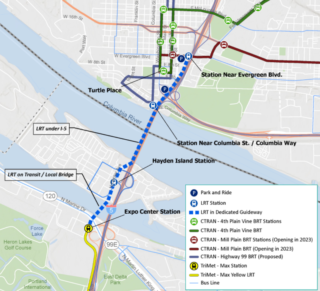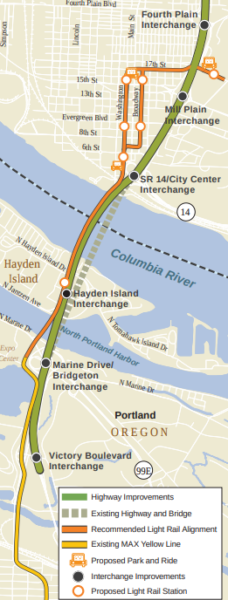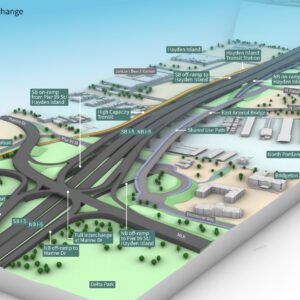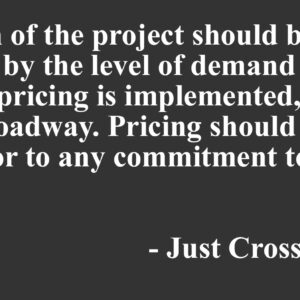
Yesterday we covered the announcement that the highway footprint for an expanded I-5 between Washington and Oregon had been narrowed down to two options: an expansion nearly identical to the 2013 Columbia River Crossing project and an option with one fewer “auxiliary lane” in each direction. At the same time as that announcement, the project team also announced they have narrowed down the options for high-capacity transit between Expo Station and Vancouver to one.
After studying 11 different options for either light rail or Bus Rapid Transit (BRT), the option recommended to move forward is a light rail line that is directly adjacent to I-5, avoids heading directly into downtown Vancouver and terminates at Evergreen Boulevard, right next to the Vancouver public library.
Since the failure of the Columbia River Crossing project a decade ago, C-TRAN has moved forward with building out its Bus Rapid Transit network, with the 4th Plain line having opened in 2017 and the Mill Plain line under construction now. So why wasn’t BRT selected here? Primarily the ability of light rail to move more riders. Capacity constraints on BRT impact how many riders can fit on each bus, and most riders will be transferring to light rail at Expo Center anyway, adding travel time.
Significantly, the IBR team noted this week that their models are currently forecasting more demand for transit across the Columbia River than any of the options they have studied so far even allow. In other words, the model projects some people who want to take transit will end up driving instead. “Transit demand exceeds peak 1-hour capacity on all modes of transit crossing the river. The mode share numbers shown assumes excess peak 1-hour demand cannot be accommodated and therefore has been shifted back to the auto mode,” a presentation footnote stated.
Advertisement

But the choice to run light rail directly along I-5 will likely prompt a lot of scrutiny. Avoiding the downtown core of Vancouver limits the walkshed of the stations, and having a massive highway next to a light rail station intended to attract riders is simply not ideal. But the fact that this alignment would have fewer property impacts was cited as a primary reason it’s moving forward. In addition, a desire not to “duplicate” the BRT service that runs along Washington Street and Broadway was cited. But duplication is not necessarily a bad thing: it reduces transfers and makes transit easier to use. The downtown Portland transit mall works well because so much service overlaps.
At Monday’s IBR Equity Advisory Group meeting, Matt Hines of Activate Inclusion raised concerns about the fact that the light rail alignment won’t provide a direct connection to Clark College, which was planned as the northern terminus for light rail as part of the Columbia River Crossing project. “The decision for high capacity transit must reflect the need to connect Portland east of I-5 in Vancouver,” because such a connection doesn’t currently exist that’s easy for people with disabilities to use, he said.
Of course, light rail is a political symbol in addition to being a mode of transit. At a legislative committee meeting on Thursday, State Senator Lynda Wilson (R-17), who represents the eastern portion of Vancouver, signaled she was ready to vote no on approving the project with light rail included. Senator Wilson, throwing out suggestions that TriMet’s light rail system is in bad financial shape, repeatedly expressed skepticism that light rail would have a lower cost-per-rider because it has higher capacity. “I don’t think laying rail is going to be cheaper in the long run than buying another bus. I don’t see how this ever pencils out,” she said.
Wilson was joined by Representative Jaime Herrera Beutler, who represents the entirety of southwest Washington in Congress. “I could not be more disappointed by today’s announcement that I-5 bridge replacement officials are advancing two final project options that do not include Bus Rapid Transit, while both would extend Portland’s light rail system into Clark County,” she wrote in a Facebook post Thursday night. “This decision flies in the face of Southwest Washington voters who have soundly and repeatedly rejected bringing Portland’s light rail to Washington state along with the massive cost, river traffic limitations and public safety concerns that come with it.” Light rail bringing additional crime to an area is a conservative trope that frequently pops up in discussions of transit expansion here and elsewhere. But the pushback on light rail in Clark County is likely contributing to the final decision not to deviate from I-5’s footprint there.
Representatives from both TriMet and C-TRAN came out in strong support of the option to terminate at Evergreen, and it seems likely that many other elected officials weighing in on the project overall will defer to those agencies when it comes to the high capacity transit alternatives. Whether politics can derail the decision now remains to be seen.
CORRECTION, 4/25 at 3:20pm: This story originally misidentified Matt Hines of Activate Inclusion. We regret the error.






Thanks for reading.
BikePortland has served this community with independent community journalism since 2005. We rely on subscriptions from readers like you to survive. Your financial support is vital in keeping this valuable resource alive and well.
Please subscribe today to strengthen and expand our work.
As a MAX user for the past 20+ years, I’d vote for BRT every time. So much more flexible than a fixed mode train.
Train breaks down, it blocks tracks, and no one moves.
Bus breaks down, next bus picks up stranded passengers and goes around and on its merry way.
I’m pro-transit, just not pro-train for in-city transportation. Long distance would be great to have high speed trains crisscrossing the country (even the world).
But BRT does not stimulate real estate investment profits as well as LRT.
While I understand that LRT has a much lower cost of operation and will eventually pencil out as cheaper overall (how long does it take for the lowered cost of operation to balance out the higher cost of implementation?) – As a long term MAX rider (Since the westside got MAX – over 20 years if I’m not mistaken) I regularly run into the massive flaw in LRT – a broken down train stopping *everything* up the line. Unless you’re lucky enough to have it happen at a spot where the train can be taken out of the line, or bypassed – you are *STUCK*.
Also, while the original Type 1 trains are technically still in service, they’ve been overhauled several times and I’m not sure we wouldn’t have been better off with new ones sooner (those Type 6’s would sure be nice to have in their place).
Worse, TriMet communicates *so* poorly in these situations that someone like me who has the option to ride around the break often doesn’t because you keep hearing “we’ll be here for just s few minutes” and it’s not until an hour has gone by that you realize you should have just put your helmet on and ridden off (last Friday on the Green Line was a classic example of this).
A nice full (think the rush hour standing room only trains from downtown to Beaverton) MAX train transports a very large amount of people at very low cost. But these days they run at about 1/2 capacity at their fullest.
If BRT allowed us to more fully integrate CTran and TriMet trips (and get higher capacity service to more places on the east side and out the SW corridor sooner) then it’s the correct choice for this.
OTOH – maybe the project will get scuttled by including LRT – that’s not a half bad result either.
The solution to not enough people is to drastically improve where the MAX goes, ie, bring it to more people. Start with the SW corridor, move on to Forest Grove and Cornelius (There is literally an unused line out there that’s ready, and the project would be less than $300M). Go out to McMinville along 99W, out to Tigard through Oregon City via the Yellow Line (and merge the Orange Line with it).
This would cost a lot of money and lots of pushback from Yamhill County, but overall, it would be worth it for everyone.
Also, crazy idea: equip the MAX trains with buffers that would allow them to push a stopped train.
Would love to see an infill station around Sylvan too, with a bus ferrying people from the Raleigh Hills area. Sunset and Oregon Zoo are too far away for anyone living in the area and there’s some dense apartment buildings along/around Beaverton Hillsdale Highway (a light rail on Beaverton Hillsdale would also be a great alternative).
Building our public transit system around bringing commuters into downtown is how we ended up with this useless system in the first place.
People who live in dense parts of the metro can’t use public transit, it’s wild we are even considering fixed rail through low density suburbs.
We need to focus on people who can realistically use public transit. Not putting low use lines out to Forest Grove
I would say, most importantly, we need to focus on providing more housing where people can realistically use transit. With enough density–that is to say, multistory condominium and apartment complexes, with ground-level industry/retail, equal-cost rehousing of those displaced or in place, little to no parking, and an absolute proportional low-income-housing provision (none of this >19 units provision nonsense; X% of all units)–people will be looking for better frequency, and only after that is expanding service to new areas really important.
Intensification of usage is needed much more than extensification of service.
So resources for bougie gentrifiers but other less dense areas (where poor people disproportionately live) can go #@$% themselves?
The idea that only areas with some market fundamentalist-urbanist approved level of density deserve mass transit (or a massive increase in density) is so bloody exclusionary.
Unless we have Tokyo levels of service density and Seoul/Paris levels of housing density and are STILL not able to house the poor near transit, there is nothing to suggest that putting transit where it can be most useful is exclusionary.
Even suburbs in Tokyo have good rail service, but suburban homes in Tokyo are not half-acre plots along and between stroads. I’m all for tearing down our wasteful land use patterns and rebuilding them to work with transit, but pretending that Forest Grove–or most other Portland suburbs–as it sits today can be well-served by transit is just delusional, and will do nothing to abate the excessive resource consumption by “USAnian” dysfunctional urban economics.
What is it with you and strawmen?
The work required to build and operate public infrastructure — water, transit, broadband, you name it — is inversely related to population density.
This is a matter of physics, not economics.
I guess my memories of how transportation functioned in Romania (one of the poorest nations in the global north at that time) and Spain are a false memory implanted by aliens.
TriMet asked to spend $49,331 per foot to extend the MAX 11 miles, and running the trains was going to cost extra. If voters had approved this plan, inflation would already be blowing a hole right through it.
We have plenty of existing lanes that can be re-allocated to genuine BRT. This would also greatly increase low-occupancy vehicle congestion which is a very, very good thing.
The idea that we can’t have density and mass transit links in Forest Grove where many immigrants live is so bloody USAnian. Randian market fundamentalism is the least optimal way to provide shelter/housing and basic resources.
Is there any news on bike/ped improvements? Bike/ped access on the new bridge couldn’t any worse unless they eliminated it completely.
I firmly disagree, this could easily end up with something like the glenn jackson, i.e. worse connections on both ends, a much higher elevation to have to bike over, loss of access to hayden island, and the whole thing is a very narrow path with light posts jutting out into it in the middle of a 10+ lane freeway. The existing bike infrastructure isn’t great, but it could absolutely be worse on the replacement bridge.
I would think this was cool if the train was grade-separated and could actually go fast, and every single line didn’t cross the Willamette over a single, 110-year-old bridge with 2 tracks and a maximum speed of 10 (ten!) MPH. We need a tunnel or elevated tracks.
A tunnel would be a better option for Portland. I say build a tunnel, move the trains beneath it, and return the surface to buses. The MAX has no business being on the surface streets. The tricky part about underground is that we have a lot of underground waterways in the Willamette Valley, and we’d need to deal with those. It would be much easier to have the Yellow Line not on the bridge.
And while we’re talking about the Yellow line, can we please merge the Orange line with the Yellow line? There is no point in separating them, and it just forces people to transfer.
Most Yellow Line trains do continue on as Orange Line trains
It is still true that every single MAX train trip that goes over the Tilikum Crossing also crosses the Steel Bridge before or afterwards. No light rail vehicle can travel from a maintenance facility to the Tilikum Crossing without first crossing the Steel Bridge, and the same goes for light rail vehicles at the end of the day. When the Steel Bridge is blocked, Orange Line trains in service can loop back at Union Station, but are unable to access the rest of the light rail network.
If I was designing the transit for this project, I’d take light rail only as far as a one-block transit plaza in downtown Vancouver, south of 5th Street between Washington and Main. Make the 5th Avenue Transit Center the terminus for every C-TRAN bus that runs downtown, including all three BRT lines. It would be cheap as far as LRT goes, and would provide easy transfer from MAX to perhaps a dozen bus lines.
Downtown Vancouver does not have the population to support MAX. Commuters riding MAX will either need to be convinced to park at existing park&rides and ride the bus to the max connection downtown or Vancouver will have to give up future apartment/office buildings for park&rides downtown.
The original CRC plan for MAX called for two blocks of parking garages between Columbia and Washington streets and the railroad tracks and 5th street. Commuters heading south would have had to get off at Mill Plain and then drive 5 or 6 blocks through downtown to get to the garage. They would be competing for road space with people currently living downtown and trying to get onto I5. Part of these blocks have now been developed as office space and another is to be apartments.
A dozen bus lines converging at a downtown transit center will deliver commuters from all over Vancouver to MAX. It’ll work for everyone living along a downtown-bound C-TRAN line, as long as they are headed to jobs in or near downtown Portland and can make the trip with one transfer.
C-TRAN’s job would be to build a transit center just north of the bridge. All Tri-Met needs to do is get MAX over the river to make the connection.
Oh, of course, public safety! The age-old myth that light rail brings crime is alive and well, and totally not a just a highway lobby talking point!
Many studies have been conducted on this very question, and they all find differing results, from increases to even decreases!
Consider this, the MAX has cameras, operators, and riders, all who could act as a witness to a criminal. This is why most crime is committed with cars (which studies and just American culture itself have confirmed). The myth is perpetrated by some of big oil’s many dark-money groups, who use anecdotes from police officers, disgruntled transit employees, manipulated statistics, and freak incidents like the Portland stabbing in 2017.
If it isn’t true, then why is this myth so effective? The answer is racism and xenophobia. Conservatives use this troupe to stoke fears of some “other” that will tarnish the “pure” suburban communities. Transit is seen as “the poor man’s ride,” meaning anyone who rides transit will have all those stereotypes associated with them. Ironic because poverty is a motivating factor in crime, and LRT can reduce poverty.
The MAX does not bring crime. That is a racist lie.
Rant over. I’m sorry about this, I just need to get this out there, because I’m fed up with people saying this.
If the yellow MAX line is included would it have to stop for bridge lifts for river traffic. Having MAX not being interrupted seems to imply that the bridge is high enough that it does not need to be raised. A taller bridge with no lift function was rejected last time bridge replacement was discussed.
Any bridge high enough to support river traffic and have a max train hanging below it is going to be a problem for Pearson Airport. You can’t have a bridge high enough to support the commercial river traffic needs and low enough for that airport to continue operating as it is now.
I am pretty shocked to see an alignment of the light rail below the deck of the bridge. One of the many many problems with the original CRC design was that it was too low to allow important commercial river traffic through. If they have raised the bridge enough to allow that traffic plus light rail under the bridge then that would mean that the bridge itself must be much taller, an issue for anyone who is trying to bike over it. Let’s keep the drawbridge improve the bike connections and not build an enormous hill that will serve a barrier to people biking across the river.
For better or for worse, that sounds like a ton of different BRT, light rail, and commuter rail stations.
Light rail isn’t being built for Downtown Vancouver. It’s being built for Portland and the Clark County commuters that currently drive across the bridge. Unfortunately, a large park and ride with easy freeway access will probably draw the largest number of riders.
There are currently quite a few people that walk from downtown to Fort Vancouver along Evergreen Street. The original CRC called for a cap across the freeway here. This might actually make a nice station if it is planned well.
BRT makes all sorts of sense *for the crossing itself*.
It would allow one-seat rides from the Vancouver suburbs. and provide flexibility for the bus lines to be adjusted as needed over time.
… but …
It would only work if the dedicated BRT route were continued right into downtown Portland to avoid the huge bottleneck of a jam that will develop on I-5 between the bridge and downtown Portland because of the additional traffic that the bridge will engender.
The BRT route would have to built simultaneously as part of the bridge replacement. If promised for “the future” we all know that will never occur.
But we all know that separate BRT lanes along the existing I-5 into downtown Porltland isn’t going to occur … not now, not in the forseeable future. It would be horribly expensive and its construction would be even more horribly disruptive. It would likely require rebuilding many of the overpasses and interchanges. It’s unfortunale that it’s more likely that I-5 would be widened and expanded to more general traffic lanes into dowtown Portland.
An added concern is that BRT encourages a more difuse network of bus lines and roads throughout the region. It would encourage more sprawl like that which has afflicted LA, Phoenix, Dallas, etc.
So all things considered, light rail across the bridge makes the best choice.
I don’t know that it was ever realistic to try and run light rail down Washington street. The onramps for I-5 and SR14 will be at Fifth and Washington street. You risk the MAX line getting stuck in traffic if the onramps get backed up
The second issue is that light rail will be coming into town from roughly 100 feet above the river at the existing channel and then over the railroad tracks near 3rd and would need to be at street level by 5th. Any flexibility that there was in bringing light rail into town has been removed due to continuing development downtown. A 5-story office building has been built on Washington Street against the railroad tracks and ground is set to be broken soon on a 5 or 6-story apartment building at 4th and Washington.
Someone was asking about the bike/pedestrian access to the bridge. I’m sure it’s been posted here before, but I’ll paste a link below that shows a sketch of how the new bridge is planned to come into Vancouver. It looks like a 4 or 5-story loop will be built to get bikes from Columbia Street near Columbia Way up and onto the bridge.
This links to a Columbian article. I couldn’t find the sketch on the official IBR website.
https://www.columbian.com/news/2022/jan/20/i-5-bridge-replacement-program-unveils-visuals-an-example-of-direction-were-going-official-says/
If those dingbats think the undesirables somehow can’t get on a bus to get to Vancouver, I suggest they ride some TriMet buses 😉
The crime train trope is so weird. Like…”rail is so much better than a bus that we think everyone will want to use it, that’s why we reject it!”
Hi Steve, I can’t repost your comment on the right article but if you copy and paste it in the comments of the other article I will approve it and delete this one.
Wow, this is really terrible. It doesn’t even have a direct transfer from the 4th Plain Vine. I think this plan just shows that the transit element of this project is just a check box to get more Federal funding.
The Vine also goes down Broadway and Washington, so I thought it did overlap with Turtle Plaza. But no! It’s a block away or more. That *IS* a massive oversight.